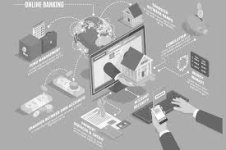The Role of Information Technology in the Banking Sector
In the rapidly evolving world of finance, information technology (IT) has become an essential pillar of the modern banking system. From enhancing the customer experience to revolutionizing internal operations, IT has transformed traditional banking into a highly efficient, digital-first industry. Banks are no longer limited by geography or traditional working hours, thanks to the widespread adoption of digital platforms powered by technology.
Information technology has drastically improved how customers interact with their banks. Online and mobile banking platforms offer real-time access to accounts, enabling users to perform transactions, check balances, and even apply for loans without visiting a physical branch. The integration of AI-powered chatbots and virtual assistants allows banks to provide instant support and resolve queries efficiently. Additionally, data analytics helps banks understand customer behavior and preferences, allowing them to offer personalized products and services tailored to individual needs.
As digital banking grows, so do concerns around security. IT plays a critical role in protecting sensitive financial information through encryption, multi-factor authentication, and secure communication channels. Advanced security measures like biometric verification, facial recognition, and tokenization ensure that customer identities are protected. Moreover, machine learning algorithms can monitor transactions in real time, identifying patterns that signal potential fraud and stopping threats before they escalate. These innovations significantly enhance the trust customers place in digital banking systems.
Beyond customer-facing benefits, IT has revolutionized back-office operations. Tasks that once required manual input, such as account management, loan processing, and compliance reporting, can now be automated. Robotic Process Automation (RPA) and cloud computing allow banks to scale operations quickly and manage vast amounts of data with ease. Centralized core banking systems facilitate seamless integration across branches and services, leading to faster turnaround times, reduced errors, and substantial cost savings.
One of the most impactful roles of IT in banking is its ability to promote financial inclusion. Digital banking has made it possible for individuals in remote and rural areas to access essential financial services. Mobile money platforms, internet banking, and app-based services have helped bridge the gap for the unbanked population. These technologies enable users to send and receive money, pay bills, and even access credit without visiting a branch — helping to foster economic participation and financial literacy across diverse communities.
Information technology is also at the core of banking innovation. Services like blockchain-powered transactions, digital wallets, and peer-to-peer lending platforms are reshaping how people manage and move money. Banks are partnering with fintech startups and adopting open banking models through APIs to provide customers with a broader range of services. These innovations are not only convenient but also open up new revenue streams and improve long-term competitiveness in the financial sector.
In the rapidly evolving world of finance, information technology (IT) has become an essential pillar of the modern banking system. From enhancing the customer experience to revolutionizing internal operations, IT has transformed traditional banking into a highly efficient, digital-first industry. Banks are no longer limited by geography or traditional working hours, thanks to the widespread adoption of digital platforms powered by technology.
1. Enhancing Customer Experience
Information technology has drastically improved how customers interact with their banks. Online and mobile banking platforms offer real-time access to accounts, enabling users to perform transactions, check balances, and even apply for loans without visiting a physical branch. The integration of AI-powered chatbots and virtual assistants allows banks to provide instant support and resolve queries efficiently. Additionally, data analytics helps banks understand customer behavior and preferences, allowing them to offer personalized products and services tailored to individual needs.
2. Strengthening Security and Fraud Detection
As digital banking grows, so do concerns around security. IT plays a critical role in protecting sensitive financial information through encryption, multi-factor authentication, and secure communication channels. Advanced security measures like biometric verification, facial recognition, and tokenization ensure that customer identities are protected. Moreover, machine learning algorithms can monitor transactions in real time, identifying patterns that signal potential fraud and stopping threats before they escalate. These innovations significantly enhance the trust customers place in digital banking systems.
3. Driving Operational Efficiency
Beyond customer-facing benefits, IT has revolutionized back-office operations. Tasks that once required manual input, such as account management, loan processing, and compliance reporting, can now be automated. Robotic Process Automation (RPA) and cloud computing allow banks to scale operations quickly and manage vast amounts of data with ease. Centralized core banking systems facilitate seamless integration across branches and services, leading to faster turnaround times, reduced errors, and substantial cost savings.
4. Supporting Financial Inclusion
One of the most impactful roles of IT in banking is its ability to promote financial inclusion. Digital banking has made it possible for individuals in remote and rural areas to access essential financial services. Mobile money platforms, internet banking, and app-based services have helped bridge the gap for the unbanked population. These technologies enable users to send and receive money, pay bills, and even access credit without visiting a branch — helping to foster economic participation and financial literacy across diverse communities.
5. Enabling Innovation and New Services
Information technology is also at the core of banking innovation. Services like blockchain-powered transactions, digital wallets, and peer-to-peer lending platforms are reshaping how people manage and move money. Banks are partnering with fintech startups and adopting open banking models through APIs to provide customers with a broader range of services. These innovations are not only convenient but also open up new revenue streams and improve long-term competitiveness in the financial sector.

